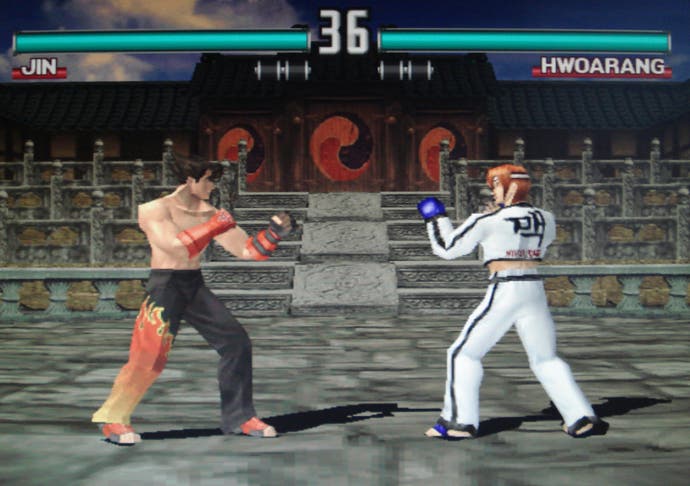Hardware Focus: Acer HN274H 3D Monitor
Meet the 27-inch screen that works with all 3D gaming formats.
Scaling and Video Processing
Moving on, and most HDTV manufacturers put a lot of emphasis on video processing, with many companies providing exceptionally high quality scaling routines that retain all of the finer details in both SD and 720p material with minimal side-effects. On the other hand, this is far less of an issue when it comes to monitors, considering that most users will be running their regular PCs - or high-end gaming rigs - at their display's native resolution. This is great if you have the hardware capable of doing this while running the latest, most graphically intensive games. But this isn't something the PS3 or Xbox 360 can do with ageing, five year old technology.
While the quality of the upscaling on the HN274H isn't a match for most mid to low-end HDTVs (specifically those offered up by the likes of Samsung, LG, and Panasonic), it does fare a lot better than many PC monitors on the market. Acer employs a scaling algorithm which gives the resized image a slightly smoother look, although it fails to suppress a lot of the jaggies and harsh edges in lower resolutions. Here we've put together a series of photos which should give you a better idea of how well the monitor performs - pay close attention to the edges.




720p content can look decent enough when being viewed from a few feet away and similarly, reminds us of the look present in the console versions of Call of Duty (albeit softer) with their 1024x600 framebuffer resolutions. However, things do appear visibly cleaner in 3D, where a large amount of the side-effects present from displaying a scaled image are much less perceivable to the eye compared to viewing in 2D. Here, Acer's solution acquits itself quite well.
Standard definition content - both 480p and 576p - is watchable, although fine details get blurred and there's a fair amount of additional jaggies on screen. Our tests with Tekken 5 running in progressive scan mode (480p) reveals a lot of amplified aliasing and edge shimmering which the additional blur failed to conceal. However, the overall image is far from a fuzzy mess, and doesn't look too bad when viewing from a distance. The effect you see is similar to how most displays treat the Wii during scaling.
That said, film and video sources look much better than games when scaled. This is largely because these types of material aren't pixel based in their native form, and as such feature less in the way artificially harsh lines and jaggies. Softness and loss of fine detail are still present due to the scaling process, but the end result looks more pleasing to the eye.
Outside of basic upscaling and deinterlacing, the HN274H doesn't feature any other processing capabilities of note - there's no 120Hz frame interpolation to reduce motion blurring on 60Hz content, like you'll find on many HDTVs, and 24p support for Blu-Ray playback is also absent. However, these aren't terribly important when it comes to a display geared towards gaming. The use of 120Hz can make 30FPS content appear visibly smoother on some displays that use it, delivering a 60fps styled look to the things although this can introduce unwanted input lag, which takes away any potential benefits: we were not particularly bothered about its absence here.
Interestingly, there does appear to be some a very mild form of edge-enhancement (artificial sharpening of the image) activated at all times, which manifests itself as a very thin, barely visible halo around straight lines. The good news is that this is only noticeable when scrutinising the monitor up close (very, very closely), and not during regular viewing distances. This has no impact on real world viewing whatsoever.
The Digital Foundry Verdict
Despite its flaws, the HN274H is an interesting prospect. At 27 inches there are few monitors out there that support 3D and 120Hz, while competing 32-inch HDTVs don't offer up the same flexibility when it comes viewing stereoscopic content across a wide range of devices - for example, you can't use them for full HD NVIDIA 3D Vision games. Response times are also great, with input lag being no problem at all - even at low resolutions, where there is lots of scaling taking place, the Acer keeps lag down to a bare minimum. Fast motion is also nicely handled at 120Hz, with less ghosting being present compared to when viewing content at 60Hz. In these respects, it's a great monitor for gaming.
On the other hand image quality is compromised by the company's choices with regards to achieving a high level of panel brightness, and ensuring that the display has enough light output for 3D viewing in all lighting conditions. As a direct result, colour accuracy has been compromised and it's impossible to get an image that meets the industry standards for picture performance. We'd really like to see the full range of greyscale and colour management controls in the user menu, in-line with what many HDTVs are offering (even lower end ones) to make calibration easier. Black levels are poor - although not a surprise given that the HN274H uses a TN panel - and the amount of visible cross talk when watching 3D content can be very distracting.
That said, the 27-inch size is perfect for desktop viewing of both 2D and 3D content. Watching movies in either format is quite an immersive experience with the picture filling your whole field of view, while this works especially well for stereoscopy, almost making the display seem like a window to another world. Again, this works wonderfully for gaming, and proves that you don't need a massive screen to do this.
Desktop use is by all accounts, fine. Up close the 1080p resolution at this screen size doesn't look as pin sharp as smaller 22 or 24-inch displays. Although the bigger screen means that you can work from further away - eyesight permitting of course.
Overall, Acer has really tried in creating a worthwhile alternative to smaller screen HDTVs, although there are quite a few stumbling blocks which really prevent it from garnering a recommendation. The issues on our unit made it impossible to recommend over and above competing monitors out there. Acer's smaller GD245HQ offers similar performance, but reportedly without the crosstalk problems present on the HN274H, while Alienware's own range of TN-based LCD screens feature much better colour accuracy and black levels.
As an all-round monitor for a variety of sources, the HN274H is extremely flexible, but performance is merely average and as a dedicated desktop monitor and HDTV replacement in one, there are better solutions available. Gamers will definitely appreciate the decent-enough upscaling (for a monitor) and low levels of lag, but the flaws in other areas are ones we can't really ignore.
Article by David Bierton.